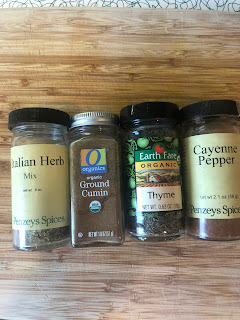This is a fantastic, fresh, light, vibrant salad that's perfect for late winter into early Spring when all of the ingredients are in season. The mélange of flavors and textures work together in perfect harmony.
For a recent recent dinner gathering with friends, we selected to bring the salad course. The theme of the gathering was "Farm to Table." I noticed what was in season on our weekly Farmer's Market visits. When I saw a salad in one of my Alice Water's cookbooks it matched up perfectly with what was available at the Farmer's Market. Our citrus vendor was getting close to finishing up with the blood oranges. Our vegetable vendor had plenty of beets and always has bags of arugula. Waters' salad called for endive but I did a trial run for some friends and decided to make a switch from endive to arugula. I also decided to use pistachios instead of walnuts. The addition of crumbled goat cheese was the perfect ingredient to give the salad a hint of creaminess.
Why use blood oranges when you can just use more common oranges? First, there's the deep red color that will be present in the fruit and the juice. While it may appear "blood-like," it's actually anthocyanin, a natural chemical compound. This compound is present in blueberries, blackberries, tomatoes, rhubarb, etc. The deep red color, along with the red beets, gives this salad an interesting color. Blood oranges also taste slightly different from other oranges. They are sweeter than regular oranges but also less tart making it a better choice for this salad. But, yes, you can use other oranges but if you can get blood oranges, go for it and give it a try.
Serve the salad on one or two large platters and let your guests take as much as they want.
Beets, Blood Oranges, and Arugula Salad
Serves 6
Ingredients:
- Beets - 10 medium beets, mixed red and gold
- Blood oranges - 6, peeled with a knife
- Arugula - 5-6 oz.
- Avocados - 4, cut in half, pitted, and diced
- Roasted pistachios - 3/4 cup
- Goat cheese - 6 oz.
- Orange juice - 4 Tbsp., fresh is better but store bought will work
- Orange zest - from 1 orange (regular if using fresh oranges or use the blood oranges)
- Olive oil - 1/2 cup
- White balsamic vinegar - 4 Tbsp.
- Honey - 2 Tbsp.
- Salt and pepper - to taste
- Preheat oven to 400º
- Trim and wash the beets and roast them in a covered dish with just enough water to cover the bottom. Roast colors separately.
- Zest one of the oranges using a microplane.
- While the beets roast, use a knife to trim off the top and bottom of each blood orange. Pare off the rest of the peel and remove the pith.
- Slice the oranges crosswise into 1/4 inch rounds and quarter each slice.
- When beets are done and cool enough to handle, peel them and slice into rounds and quartered.
- Make the vinaigrette by mixing the vinegar, orange juice, zest, and honey. Slowly whisk in the olive oil. Season with salt and pepper.
- To serve, place all beets in a large bowl and add a little bit of the vinaigrette and stir to coat.
- Cover the bottom of a serving platter with the beets.
- Place arugula, blood oranges, and pistachios in a large bowl. Slowly add the some dressing and stir to mix and allow the vinaigrette to break down the arugula ever so slightly.
- Distribute the salad mix on top of the plated beets. Top with additional pistachios and crumbled goat cheese.

























